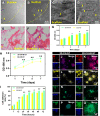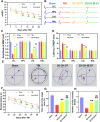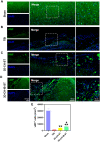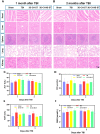3D printing of injury-preconditioned secretome/collagen/heparan sulfate scaffolds for neurological recovery after traumatic brain injury in rats
- PMID: 36536463
- PMCID: PMC9764714
- DOI: 10.1186/s13287-022-03208-0
3D printing of injury-preconditioned secretome/collagen/heparan sulfate scaffolds for neurological recovery after traumatic brain injury in rats
Abstract
Background: The effects of traumatic brain injury (TBI) can include physical disability and even death. The development of effective therapies to promote neurological recovery is still a challenging problem. 3D-printed biomaterials are considered to have a promising future in TBI repair. The injury-preconditioned secretome derived from human umbilical cord blood mesenchymal stem cells showed better stability in neurological recovery after TBI. Therefore, it is reasonable to assume that a biological scaffold loaded with an injury-preconditioned secretome could facilitate neural network reconstruction after TBI.
Methods: In this study, we fabricated injury-preconditioned secretome/collagen/heparan sulfate scaffolds by 3D printing. The scaffold structure and porosity were examined by scanning electron microscopy and HE staining. The cytocompatibility of the scaffolds was characterized by MTT analysis, HE staining and electron microscopy. The modified Neurological Severity Score (mNSS), Morris water maze (MWM), and motor evoked potential (MEP) were used to examine the recovery of cognitive and locomotor function after TBI in rats. HE staining, silver staining, Nissl staining, immunofluorescence, and transmission electron microscopy were used to detect the reconstruction of neural structures and pathophysiological processes. The biocompatibility of the scaffolds in vivo was characterized by tolerance exposure and liver/kidney function assays.
Results: The excellent mechanical and porosity characteristics of the composite scaffold allowed it to efficiently regulate the secretome release rate. MTT and cell adhesion assays demonstrated that the scaffold loaded with the injury-preconditioned secretome (3D-CH-IB-ST) had better cytocompatibility than that loaded with the normal secretome (3D-CH-ST). In the rat TBI model, cognitive and locomotor function including mNSS, MWM, and MEP clearly improved when the scaffold was transplanted into the damage site. There is a significant improvement in nerve tissue at the site of lesion. More abundant endogenous neurons with nerve fibers, synaptic structures, and myelin sheaths were observed in the 3D-CH-IB-ST group. Furthermore, the apoptotic response and neuroinflammation were significantly reduced and functional vessels were observed at the injury site. Good exposure tolerance in vivo demonstrated favorable biocompatibility of the scaffold.
Conclusions: Our results demonstrated that injury-preconditioned secretome/collagen/heparan sulfate scaffolds fabricated by 3D printing promoted neurological recovery after TBI by reconstructing neural networks, suggesting that the implantation of the scaffolds could be a novel way to alleviate brain damage following TBI.
Keywords: 3D printing; Biomaterial scaffolds; Human umbilical cord blood mesenchymal stem cells; Injury-preconditioned secretome; Neural reconstruction; Traumatic brain injury.
© 2022. The Author(s).
Conflict of interest statement
The authors declare that they have no competing interests.
Figures









Similar articles
-
Three-dimensional-printed collagen/chitosan/secretome derived from HUCMSCs scaffolds for efficient neural network reconstruction in canines with traumatic brain injury.Regen Biomater. 2022 Jun 27;9:rbac043. doi: 10.1093/rb/rbac043. eCollection 2022. Regen Biomater. 2022. PMID: 35855109 Free PMC article.
-
[Effect of chitosan porous scaffolds combined with bone marrow mesenchymal stem cells in repair of neurological deficit after traumatic brain injury in rats].Zhongguo Xiu Fu Chong Jian Wai Ke Za Zhi. 2018 Jun 15;32(6):745-752. doi: 10.7507/1002-1892.201712047. Zhongguo Xiu Fu Chong Jian Wai Ke Za Zhi. 2018. PMID: 29905055 Free PMC article. Chinese.
-
3D printing collagen/heparin sulfate scaffolds boost neural network reconstruction and motor function recovery after traumatic brain injury in canine.Biomater Sci. 2020 Nov 21;8(22):6362-6374. doi: 10.1039/d0bm01116a. Epub 2020 Oct 7. Biomater Sci. 2020. PMID: 33026366
-
Mesenchymal stromal cell secretome for traumatic brain injury: Focus on immunomodulatory action.Exp Neurol. 2022 Nov;357:114199. doi: 10.1016/j.expneurol.2022.114199. Epub 2022 Aug 8. Exp Neurol. 2022. PMID: 35952763 Review.
-
The use of bioactive matrices in regenerative therapies for traumatic brain injury.Acta Biomater. 2020 Jan 15;102:1-12. doi: 10.1016/j.actbio.2019.11.032. Epub 2019 Nov 18. Acta Biomater. 2020. PMID: 31751809 Review.
Cited by
-
Biomaterials in Traumatic Brain Injury: Perspectives and Challenges.Biology (Basel). 2023 Dec 29;13(1):21. doi: 10.3390/biology13010021. Biology (Basel). 2023. PMID: 38248452 Free PMC article. Review.
-
Pathological axonal enlargement in connection with amyloidosis, lysosome destabilization, and bleeding is a major defect in Alzheimer's disease.Neural Regen Res. 2026 Feb 1;21(2):790-799. doi: 10.4103/NRR.NRR-D-24-01440. Epub 2024 Apr 30. Neural Regen Res. 2026. PMID: 40326989 Free PMC article.
-
A systematic review of the anti-inflammatory and anti-fibrotic potential of human umbilical cord mesenchymal stem cells-derived exosomes in experimental models of liver regeneration.Mol Biol Rep. 2024 Sep 20;51(1):999. doi: 10.1007/s11033-024-09929-0. Mol Biol Rep. 2024. PMID: 39302506
-
3D printing of interferon γ-preconditioned NSC-derived exosomes/collagen/chitosan biological scaffolds for neurological recovery after TBI.Bioact Mater. 2024 May 28;39:375-391. doi: 10.1016/j.bioactmat.2024.05.026. eCollection 2024 Sep. Bioact Mater. 2024. PMID: 38846528 Free PMC article.
-
Neurotrauma-From Injury to Repair: Clinical Perspectives, Cellular Mechanisms and Promoting Regeneration of the Injured Brain and Spinal Cord.Biomedicines. 2024 Mar 13;12(3):643. doi: 10.3390/biomedicines12030643. Biomedicines. 2024. PMID: 38540256 Free PMC article. Review.
References
-
- Shi W, Huang CJ, Xu XD, Jin GH, Huang RQ, Huang JF, et al. Transplantation of RADA16-BDNF peptide scaffold with human umbilical cord mesenchymal stem cells forced with CXCR4 and activated astrocytes for repair of traumatic brain injury. Acta Biomater. 2016;45:247–261. doi: 10.1016/j.actbio.2016.09.001. - DOI - PubMed
Publication types
MeSH terms
Substances
LinkOut - more resources
Full Text Sources
Medical

